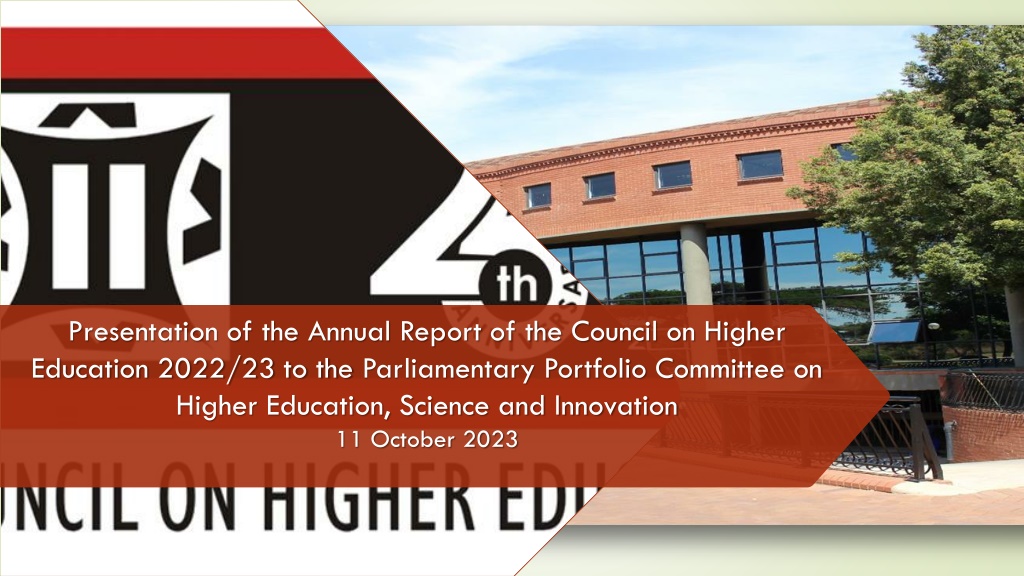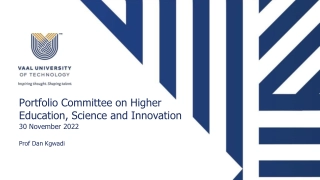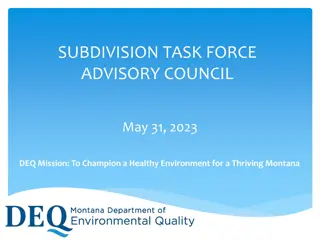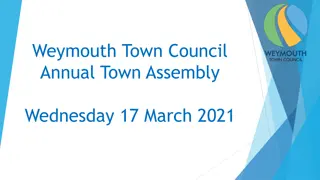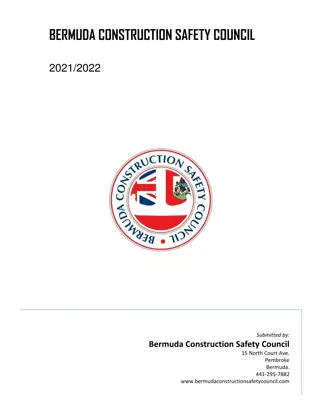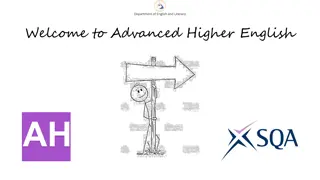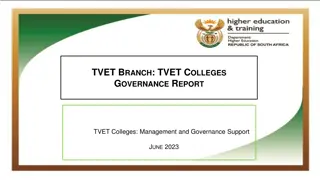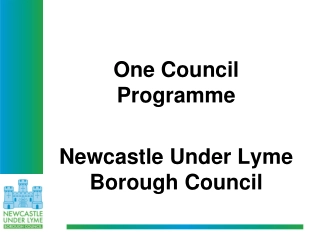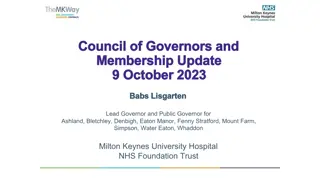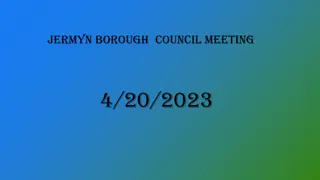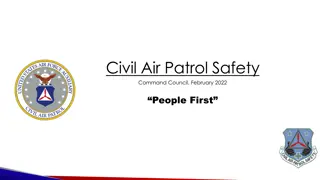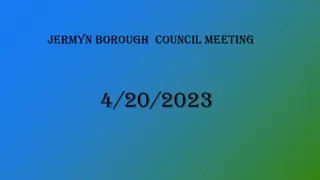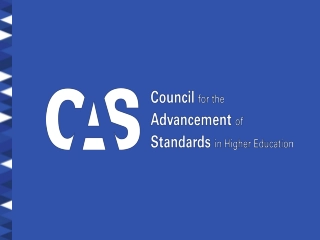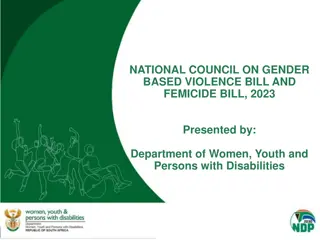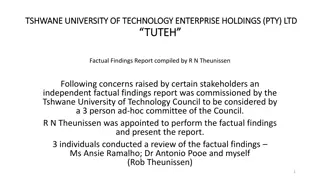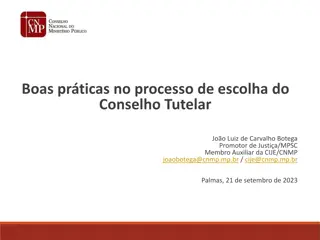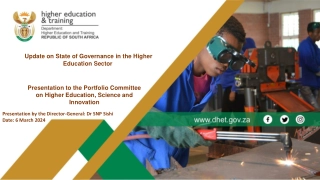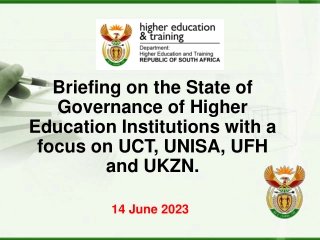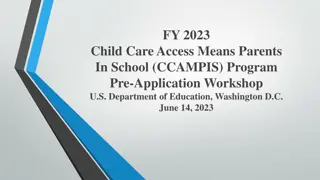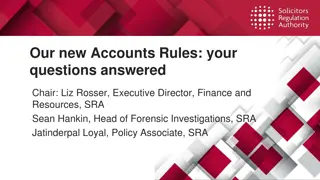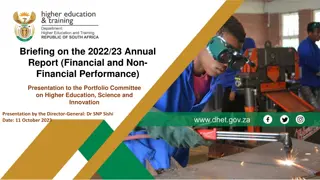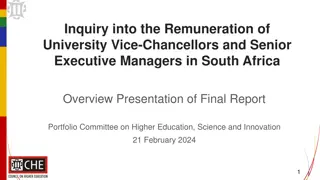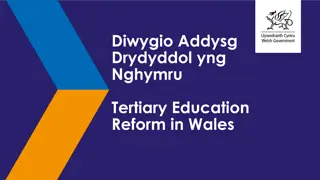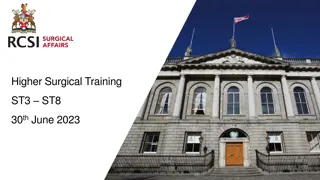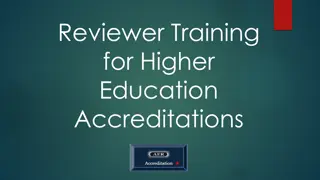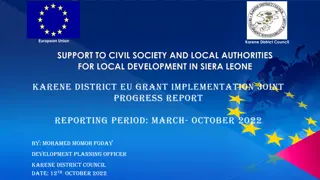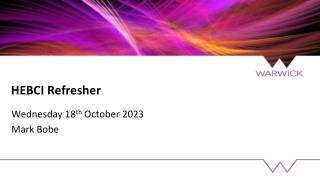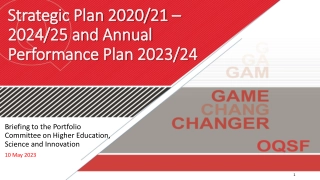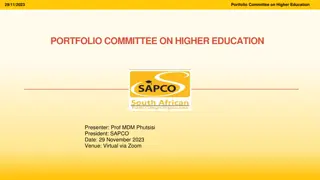Overview of Council on Higher Education's 25th Anniversary Report
Explore the rich history and future trajectories of the Council on Higher Education (CHE) in its 25th anniversary year. Delve into CHE's advisory and quality assurance roles, mandate from the Higher Education Act, and contributions to the National Qualifications Framework Act. Learn about CHE's achievements, financial performance, and funding needs presented in the annual report to the Parliamentary Portfolio Committee on Higher Education, Science, and Innovation.
- Higher Education
- Council on Higher Education
- 25th Anniversary
- Quality Assurance
- Higher Education Act
Download Presentation

Please find below an Image/Link to download the presentation.
The content on the website is provided AS IS for your information and personal use only. It may not be sold, licensed, or shared on other websites without obtaining consent from the author. Download presentation by click this link. If you encounter any issues during the download, it is possible that the publisher has removed the file from their server.
E N D
Presentation Transcript
Presentation of the Annual Report of the Council on Higher Education 2022/23 to the Parliamentary Portfolio Committee on Higher Education, Science and Innovation 11 October 2023
2023 the CHEs 25thAnniversary Year CHE History and Trajectories: A Brief Overview This booklet explores the rich history and promising future of the Council on Higher Education (CHE). It offers a comprehensive view of CHE's origins in a democratic South Africa, highlighting the key individuals, plans, and places that have shaped the organization over 25 years of its existence. In addition to its historical context, the publication also provides insight into CHE's advisory role, tracing its Research, Monitoring, and Advisory journey from 1997 to 2023. Furthermore, it examines the CHE's pivotal Quality Assurance role, charting this trajectory from 1997 to 2024, as it forges a new path in implementing the new Quality Assurance Framework (QAF). Access and download the publication by clicking the link: https://www.che.ac.za/publications/media-statements/che- history-and-trajectories-brief-overview 2
Presentation Structure Part 1: Mandate, Vision, Mission and Strategy Part 2: Achievement against Non-financial Performance Indicators Part 3: Financial Performance Part 4: Concluding Reflections and Funding Needs 3
Part 1 Mandate, Vision, Mission and Strategy Rev. V Memani-Sedile Chairperson of the Council on Higher Education 4
Mandate conferred by the Higher Education Act No. 101 of 1997 Advising the Minister on HE matters, at the request of the Minister, and proactively. Arrange and coordinate conferences. Through the HEQC, to promote QA in HE, audit the QA mechanisms of HEIs, and accredit programmes of HE. Publish information on HE including reports on the state of HE. Promote access of students to higher education institutions Perform any other functions designated to it by the HE Act, the NQF Act or by the Minister through notice in the Gazette. 5
Mandate conferred by the National Qualifications Framework Act No. 67 of 2008 Developing and managing the HEQSF. Developing and implementing policies and criteria for advancement the HEQSF. Recommending higher education qualifications to SAQA for registration on the NQF. Sets up the CHE as the Quality Council for higher education as provided for in the HE Act, with responsibility for the HEQSF. Maintaining a database of learners 'achievements and submitting the data for recording on the NLRD. Take responsibility for quality assurance in relation to the HEQSF Conducting or commissioning and publishing research of importance for the further development of the HEQSF. Advising the Minister on matters relating to the HEQSF. 6 Informing the public about the HEQSF.
An additional mandate: Transformation Oversight In 2021, Minister Nzimande requested the Council on Higher Education to consider incorporating an additional mandate to its functions that involves sectoral oversight of transformation and Council agreed to this request. The National Plan for Post-School Education and Training (NP-PSET), published and launched this year, articulates this role as follows: Monitoring the transformation of the system remains an important focus. This will be a formal function of the Council on Higher Education (CHE) going forward. The CHE will develop a systemic framework for reporting and monitoring transformation indicators. (NP-PSET, p. 75) Good progress is being made in taking on this mandate, including through the development of a Transformation Monitoring Framework for the sector. 7
Council Structure Note: A new Council and Chairperson were appointed during 2022/23. The new Council took up office from 15 December 2022. The Chairperson is appointed for a five- year term, and ordinary members for a four-year term. 8
Management Structure Note: Ms Olivia Mokgatle and Dr Makhapa Makhafola have since resigned. Dr Phumzile Dlamini has been appointed as the Director: Management of the HEQSF in a permanent capacity, and Dr Sanele Nene has been appointed as the Director: National Standards and Reviews, also in a permanent capacity. There is presently a full complement of senior management (Directors) occupying permanent positions. 9
Strategic Plan 2020-2025 Vision Innovative, quality higher education responsive to the needs of society. Mission The CHE is an independent, statutory, quality assurance and advisory body for South African higher education, which transforms lives in pursuit of an equitable, prosperous, and innovative society. In fulfilment of its role, the CHE: Leads and manages external quality assurance. Regulates qualifications through the HEQSF. Is an intellectual hub for higher education research, monitoring, policy, and critical discourse. Advises the Minister on all higher education matters. Values In pursuit of its vision and mission the CHE is committed to, and guided by the following values: Innovation Integrity Equity Respect Accountability 10
Strategic Outcomes 2020-2025 Outcome 1 To manage the development and implementation of the HEQSF policies, qualification standards and data in order to meet the goals of the NQF, NPPSET and the National Development Plan (NDP). Outcome 2 Comprehensive and coherent quality assurance system for the higher education sector To develop and implement a new Quality Assurance Framework for effective and efficient internal quality assurance (IQA) and external quality assurance (EQA) for the sector. Outcome 3 A reputable centre of intellectual discourse, knowledge generation and advice on higher education To revitalise and strengthen the research, monitoring, evaluation and advice capabilities of the CHE. Outcome 4 Governance, compliance and risk management To set the broad strategic direction, policy and tone for good governance, statutory compliance and risk management of the organisation to support the discharge of the core functions of the CHE. Outcome 5 Sustainable, responsive and dynamic organisation To design and implement an organisational architecture, business processes, capabilities and infrastructure to realise the strategy of the CHE. CHE as an effective custodian of the HEQSF 11
Implementation Programmes The realisation of the 5 strategic outcomes are being pursued through 4 implementation programmes. These are: Programme 1: Programme 2: Programme 3: Programme 4: Management of the HEQSF and Quality Promotion (Outcome 1) Quality Assurance (Outcome 2) Research, Monitoring & Advice (Outcome 3) Corporate Services (Outcomes 4 and 5) Each programme has several functions/subprogrammes. The relationship between the strategic outcomes, programmes & functions or sub- programmes follows.
Part 2 Annual Report 2022/23 Achievement against Non-financial Performance Indicators Chief Executive Officer Dr Whitfield Green 14
Some Performance Highlights The transition to a new Council has achieved with minimal disruption governance are fully operational. A new Higher Education Quality Information (HECQIS) has developed and is fully operational. The Policy on Articulation into and through Higher Education finalised, approved and has subsequently been published. Accreditation are being processed well within the set timeframes. A total of 565 proceedings were considered by the HEQC at seven meetings. applications been Committee System has been and structures all been Institutional audits at all universities were underway, and 20 of 26 panel site visits were completed in the year. Audits of 16 private HEIs were initiated. Several important publications were released including: - The Doctoral Review National Report . - Review of Higher Education 25 years into Democracy. A Access and Success in Postgraduate Studies was held attracted close to 250 delegates. conference on 5 pieces of advice were produced Minister, including two pieces that requested Minister. for the and were the by A Terms of Reference for the new Transformation Oversight function was approved by Council and it was submitted to the Minister. A permanent post occupancy rate of 85% has maintained through the financial year. The timeframe for the payment of service providers is achieved within a shorter timeframe. 30-day QAF: The first 6 higher education practice standards developed, and Council approved the design plan for the institutional quality dashboards which developed. have been been will now be 17
CHE annual/regular publications published in 2022/23 Vital Stats 2021 Kagisano 13: The Fourth Industrial Revolution and Higher Education in South Africa (May 2022) Kagisano 14: Inferences of Resilience and Agility of Higher Education from the Diverse Experiences with Emergency Remote Teaching and Learning (September 2022) Briefly Speaking 21: Dimensions of Transformation of Higher Education in South Africa (June 2022.) Briefly Speaking 22: New Higher Education Institutional Types in South Africa: A Missed Opportunity for Articulation and Differentiation? (August 2022) Briefly Speaking 23: A Reflection on Two Decades of Programme Differentiation in Higher Education in South Africa. (December 2022) Briefly Speaking 24: Critical Reflections on the Participation of African Universities in International Systems of Ranking Higher Education Institutions (March 2023) Higher Education Monitor 15: Perspectives on the possible future of higher education in South African in the era of COVID-19. The Review of South African Higher Education Twenty-five Years into Democracy 18 These can be accessed via the CHE website.
CHE Research Reports finalised in 2022/23 Several research projects have been concluded, and a number of publications based on them have been produced. These are directly linked to Ministerial advice and are usually not formally published and released, unless approved as part of the advice. International Benchmarking of Higher Education Institutional Typologies. International Benchmarking Policies and Practices of Recognition of Prior Learning. Pathway and Practices Leading to the Chartered Accountant Professional Designation. Awarding and Use of Honorary Academic Titles. Understanding Epistemic Access and Success for Historically Disadvantaged Students in South African Public Universities. Efficiency in the Utilisation of Financial Resources In Public Universities in South Africa. The increasing number and steady stream of outputs emanating from the CHE is an indication that its research and scholarship profile is growing steadily. 19
Post occupancy Notes: 2 positions on the organizational structure are filled as contract positions. The Compensation of Employees budget allocation makes it impossible to fill all the positions. Contract appointments are used in mitigation. 20
Part 3 Annual Report 2022/23 Financial Performance Chief Financial Officer Professional Accountant (SA) Dr Thulaganyo Mothusi 21
BUDGET VS REVENUE RECEIVED DESCRIPTION BUDGET ACTUAL VARIANCE Government grants & subsidies R74 486 000 R74 486 000 R0 Accreditation fees & other income R 6 179 000 R 5 145 710 (R1 033 290) Interest received - investment R 1 308 000 R 1 618 966 R 310 966 Conditional Grand (QAF) R 5 239 897 R 4 949 993 (R 289 904) Surplus funds- Rolled-over R21 125 390 R21 125 390 R0 TOTAL R108 338 287 R107 326 059 (R 1 012 228)
EXPLANATION OF THE VARIANCES Revenue Revenue from exchange transactions was lower than the budgeted amount due to a reduced number of applications for accreditation programmes processed during the financial year. Interest received during the year was more than budget due to increased interest rates during the year attracting higher interest income for the surplus reserves invested with the Reserve Bank. Balance of the unspent conditional grant to be utilized in the 2023-24 financial year as the project is still ongoing.
BUDGET VS EXPENDITURE INCURRED DESCRIPTION BUDGET EXPENDITURE VARIANCE Cost of employees R 45 565 882 R 45 413 082 R 152 800 Goods & Services R 62 772 405 R 56 652 003 R 6 120 402 Total R 108 338 287 R 102 065 085 R 6 273 202
EXPLANATION OF THE COST OF EMPLOYEE VARIANCES Employee costs were underspent due to the accumulation of funds on 3 funded vacant posts that took some time to fill, and there were some unforeseen delays in filling the posts during the year under review. The 3 funded vacant posts were from the following Programmes: One Research post from Research, Monitoring and Advice; One Director post from the Management of HEQSF; and One Director post from Quality Assurance.
EXPLANATION OF THE GOODS AND SERVICES VARIANCES The variances were attributed to underspend in by the following Programmes: Administration; Research, Monitoring and Advice; Management of the HEQSF; Quality Assurance. Programme: Administration Less legal fees claims for the period under review. Less travel expenses for governance committee meetings because some were held online. Less payments made for subsistence, payments made to Peer Academics and Honoraria for the QAF project. Repairs and maintenance underspent due to savings from reduced maintenance to the building during the financial year. Savings from centralised services requested for the period under review for Freight/Courier, Stationery, Office Supplies, Cellphones, and Internal Audit. Programme: Research Monitoring and Advice Payments made to Peer Academics for the review of enrolment planning.
EXPLANATION OF THE GOODS AND SERVICES VARIANCES (cont.) Programme: Management of HEQSF Less travel for Capacity Development, Partnership and Collaboration, and Policy Development in relation to payment for Peer Academics for research and developing guidelines on Articulation from TVETs to higher education; Payment for the Peer Academics to review HEQSF policy; Savings on outsourced service for HEQCIS Development, Data Management Support, and System Support; Less payment for Honorarium vouchers for national events, no international registration fees paid for the period under review; and No printing and publication of the Articulation report for the period under review. Programme: Quality Assurance Less Honoraria payments made for the Standard Development Working Group and Peer Academics for the IIE LLB review as panel members.
TEN COST DRIVERS AND THEIR PERCENTAGE CONTRIBUTION TO THE GENERAL EXPENSES DESCRIPTION OF THE SPENDING ITEM Peer Academics PERCENTAGE 33 IT expenses1 Travel Consultancy services and subcommittee members2 Printing and stationery Remuneration of Council and Committee members Outsourced Services Venue and catering Auditors' remuneration Training 13 9 5 5 4 4 4 2 2 1. IT expenses include licence fees, computer consumables, internet subscriptions, contract on support for HEQC online system and contract on support maintenance. Consultancy services include payment of VIP Payroll & HR system consultancy and also payment to governance subcommittees such as Accreditation; Human Resource Recruitment Committee etc. 2.
IRREGULAR, FRUITLESS AND WASTEFUL EXPENDITURE Irregular expenditure No irregular expenditure incurred as per note 26 of the Annual Financial Statement. Fruitless and Wasteful expenditure Fruitless and wasteful expenditure was incurred to the value of R20 220.00 as per note 25 of the Annual Financial Statement. This expenditure relates to flights and shuttle services for staff that were not utilized.
CONSEQUENCE MANAGEMENT Fruitless and Wasteful expenditure note 25 of the AFS The amount of R 20 220.00 relates to 4 cases of flights and/or shuttle services for CHE staff that were not utilized. With the exception of one case of the shuttle service amounting to R2 930.00 which was written off / condoned, the costs for the other 3 cases involving missed flights and associated costs were recovered in full from the officials concerned. Irregular expenditure No consequence management needed because no irregular expenditure was incurred as per note 26 of the Annual Financial Statement (AFS).
REPORT OF THE AUDITOR-GENERAL OF SOUTH AFRICA (AGSA) Audit Opinion Clean audit report. AUDIT FINDINGS 2022/2023 2021/2022 REMARKS Other important matters Applicable Not applicable Nonrecurring Supporting schedules (Fixed Asset Register) to the financial statements are not accurate. Applicable Not applicable Nonrecurring Supporting schedules (VIP Payroll Report) to the financial statements are not complete and accurate. Not applicable Nonrecurring Incomplete revenue transactions recorded in the current financial year, Applicable Not applicable Nonrecurring Non-compliance with the PFMA (ACT 1 OF 1999) National Treasury instruction note no.3 of 2021/22. Applicable
STRATEGIC AUDIT ACTION PLAN TO ADDRESS AUDIT FINDINGS ACTIONS START DATE END DATE CONCERNED SUBPROGRAMME Ensure that all supporting schedules are quality-checked for accuracy and completeness and that differences are clearly explained before submission for audit. March 2024 March 2024 Finance and SCM Compile a revenue reconciliation monthly, quarterly, and annually to accurately recognise and record when the cash is received. April 2023 March 204 Finance and SCM Ensure that SBD forms are completed and submitted for all procurements for adherence and compliance with National Treasury instruction note no.3 of 2021/22. April 2023 March 2024 Finance and SCM
BUDGET BASELINE FOR THE CURRENT YEAR AND MTEF PERIOD DESCRIPTION CURRENT YEAR MTEF PERIOD 2023/2024 R million 2024/2025 R million 2025/2026 R million 2026/2027 R million DHET Transfer R 83 887 R 87 632 R 91 536 R 95 749 Private Accreditation Fees R 6 452 R 6 739 R 7 041 R 7 365 Interest R 1 366 R 1 427 R 1 491 R 1 556 TOTAL R 91 705 R 95 798 R 100 068 R 104 670
BUDGET BASELINE ALLOCATION FOR THE CURRENT YEAR AND MTEF PERIOD DESCRIPTION CURRENT YEAR MTEF PERIOD 2023/2024 R million 2024/2025 R million 2025/2026 R million 2026/2027 R million Compensation of employees R 41 325 R 43 090 R 45 116 R 47 186 Goods & Services R 50 380 R 52 708 R 54 952 R 57 484 TOTAL R 91 705 R 95 798 R 100 068 R 104 670
NARATIVE TO THE BUDGET BASELINE OVER THE MTEF PERIOD MTEF PERIOD 2024/2025 TO 2026/27 The budget baseline injection was considered and approved by National Treasury for the MTEF period on the condition that the budget injection should be used for goods and services. The requested budget baseline injection will ensure the following: Continuous implementation of the CHE mandate; Implementing the strategic plan; and Implementing the approved quality assurance framework by all core Programmes with support from Programme: Administration.
RISKS ASSOCIATED WITH THE BUDGET BASELINE OVER THE MTEF PERIOD MTEF PERIOD 2024/2025 TO 2026/27 The COE budget does not cater for the following: All posts on the current approved organisation structure, hence some staff are appointed as Peer Academics on a fixed-term contract. The annual performance bonus salary scales are based on the employee s annual performance outcomes and increase in the annual cost of living adjustments as determined between the Department of Labour, National Treasury, and Labour Unions. The ratio between COE and Goods and services for the current year and the MTEF Period is 45% for the COE and 55% for Goods & Services.
RISKS ASSOCIATED WITH THE BUDGET BASELINE OVER THE MTEF PERIOD MTEF PERIOD 2024/2025 TO 2026/27 The Good & Services budget does not cater for /or is limited in relation to the following: All the institutional site visits that are required for effective implementation of the quality assurance functions including the travel expenses associated with these. Quality assurance is a peer-driven exercise and the budget for peer academics to be involved in quality assurance activities is limited. Additional functions and activities that the CHE is requested to undertake are outlined in the planned APP.
Part 4 Concluding Reflections Chairperson Rev. Vuyokazi Memani-Sedile 38
The budget allocation to the CHE is not sufficient to enable it to undertake all the work it is responsible for, and to enable a sufficient number of staff to be in place to do the work. The stipulated CoE to Goods and Services budget ratio is a factor that further limits the ability of the organisation to employ staff in permanent positions. This leads to too much reliance on the use of service level contracts, of contracted staff, and on the use of peer academics for core work, and in critical support areas like IT where significant investment is needed. Resourcing of the additional transformation oversight function is required. Contestation on mandate with some professional bodies create conflict and confusion in the sector. The fraudulent offering of qualifications by bogus institutions continues to be a challenge. The CHE is well-poised to introduce further aspects of the new Quality Assurance Framework in 2024. The CHE Conference this financial year will take place from 28 February to 1 March 2024 and the theme of the conference is: Deepening the Discourse on Academic Freedom, Institutional Autonomy and Public Accountability in South African Higher Education 39
CHE funding needs The budget of the CHE is under severe strain due to a range of factors including: a growing mandate and scope of work: The higher education sector is much bigger now than in the earlier years of the CHE, the private higher education sector is growing rapidly, and there is a need to bring the public and private higher education colleges more closely into the quality assurance oversight of the CHE. Additional mandates that have been added over the years include responsibility for managing the HEQSF as quality council, and the new Transformation oversight mandate. Investment in digital technologies is vital if the CHE is to carry out its work effectively in a 21st century world and in the context of the 4IR. A fit-for-purpose organizational structure is required in order for the CHE to fully and effectively execute its work, especially as it introduces the new Quality Assurance Framework. Therefore, additional funding is critical to enable the CHE to: Carry out the increased scope of work. Make progress in implementing its Digital Transformation Strategy. Ensuring a fit-for-purpose organizational structure that matches the work that needs to be done. 40
Thank You 41
